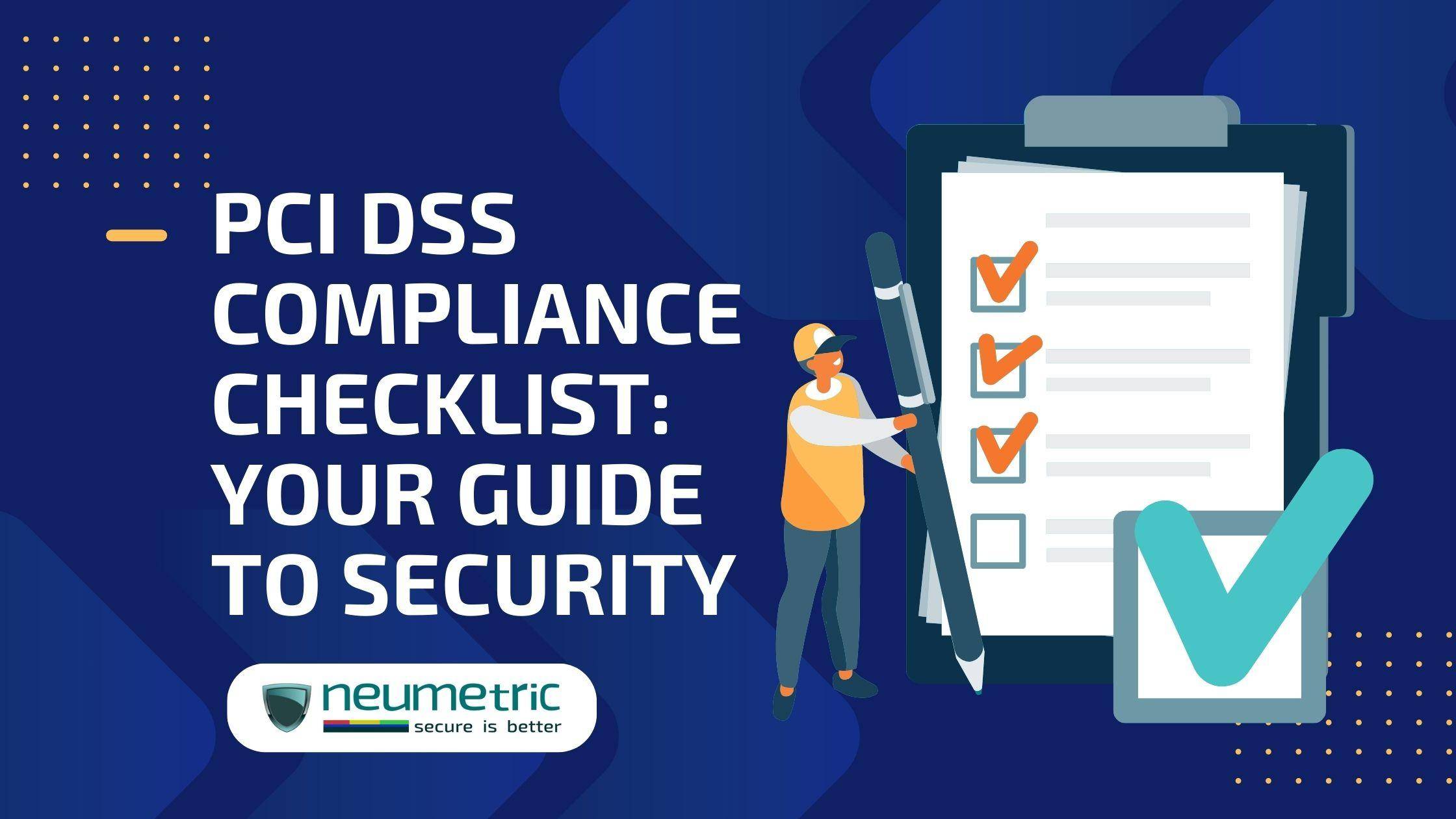Table of Contents
ToggleIntroduction – Understand the Requirements of PCI DSS Compliance
If you run a business that accepts payment cards, then you need to make sure that it’s PCI DSS Compliant. That’s because the Payment Card Industry Security Standards [PCI DSS] Council has set out Global Standards for businesses to follow in order to protect their customers’ payment information. If you’re struggling with the requirements of PCI DSS Compliance and want to know where to start, we’ve got you covered!
PCI DSS is a set of requirements that govern the security of Cardholder Data to prevent fraud and other security breaches. Compliance with PCI DSS is mandatory for any Organisation that accepts, processes, stores or transmits Payment Card Data. Failure to comply with these requirements can result in significant financial penalties, loss of reputation, and legal liability.
The PCI DSS Compliance Checklist is a valuable tool that can help Organisations assess their compliance status and ensure that they meet all the necessary requirements. This checklist covers all the 12 Requirements of the Standard, including areas such as network security, access control, data protection, and vulnerability management. Familiarity with the requirements of PCI DSS, which can be found in the official documentation is needed to become PCI Compliant. The Standard is periodically updated to reflect changes in technology and payment processing security threats, so it’s important that you understand how these updates affect an Organisation’s compliance efforts.
In this blog, we will explore each of these requirements in detail and provide you with a comprehensive guide to achieving PCI DSS Compliance. Whether you are a small business owner or a large enterprise, this checklist will help you understand the requirements of PCI DSS Compliance and take the necessary steps to protect your customers’ payment card data.
Gather Documentation and Tools to Begin Complying with PCI DSS:
PCI DSS Compliance is a crucial aspect of protecting Payment Card Data, and Organisations that accept Payment Card Data must ensure that they comply with the necessary Requirements. One of the first steps in achieving Compliance is to gather the necessary Documentation and Tools. In this section, we will explore the key Documents and Tools that Organisations need to begin their PCI DSS Compliance journey.
PCI DSS Requirements and Self-Assessment Questionnaires [SAQs]:
The PCI DSS Requirements outline the necessary Security Controls that Organisations must implement to protect Cardholder Data. These Requirements are categorised into 12 sections, each covering a specific aspect of Data Security. Organisations should review these Requirements carefully to understand the Controls that they must implement to achieve Compliance.
The Self-Assessment Questionnaires [SAQs] are documents designed to help Organisations determine their Compliance Status. There are nine different SAQs available, each tailored to different types of Organisations and payment processing methods. By completing the relevant SAQ, Organisations can identify the Controls they must implement to meet the PCI DSS Requirements.
Network Scanning and Vulnerability Assessment Tools:
To comply with PCI DSS, Organisations must conduct regular network scans and vulnerability assessments to identify and remediate any security vulnerabilities. These tools help Organisations identify and remediate any vulnerabilities before attackers can exploit them. Organisations can use commercial or open-source tools for this purpose. It is important to select a tool that meets the specific requirements of the PCI DSS Standard. The tool must be able to scan both internal and external networks, and produce detailed reports that identify vulnerabilities and suggest remediation steps.
Firewall and Antivirus Software:
Firewalls and antivirus software are essential tools for protecting Networks and Endpoints from unauthorised access and malware attacks. The PCI DSS requires that Organisations use these tools to secure their Payment Card Data Environments. Firewalls can be either hardware or software-based and must be configured to restrict traffic to and from Payment Card Data Environments. Antivirus software must be installed on all endpoints and servers that store, process, or transmit Payment Card Data.
Log Management and Analysis Tools:
The PCI DSS requires that Organisations retain detailed logs of all events that occur within their Payment Card Data Environment. Log management and analysis tools help Organisations collect, store, and analyse logs from different sources. These tools enable Organisations to identify and respond to security incidents quickly. Organisations can use commercial or open-source tools for log management and analysis. The tool must be capable of collecting logs from different sources and presenting them in a format that facilitates analysis and investigation.
Policies and Procedures:
Policies and Procedures are essential for ensuring that all staff members understand their roles and responsibilities in protecting Payment Card Data. The PCI DSS requires that Organisations develop and maintain Policies and Procedures that address different aspects of Data Security. These Policies and Procedures should cover areas such as access control, password management, incident response, and training. Organisations must also ensure that all staff members are trained on these Policies and Procedures.
PCI DSS Compliance Checklist – Your Guide to Security
As an Organisation looking to obtain PCI DSS Certification, it is important to understand the importance of Technical Security Controls and Vulnerability Management Programs when it comes to securing systems and complying with PCI DSS.
Technical Security Controls:
Technical Security Controls refer to the measures taken to protect Systems and Data from unauthorised access, modification, or destruction. These Controls include but are not limited to firewalls, intrusion detection and prevention systems, encryption, and access controls. The following are some steps that can be taken to implement Technical Security Controls:
- Install and configure firewalls: Firewalls are a crucial part of any Organisation’s Security Infrastructure. They are used to prevent unauthorised access to the network and to protect the Organisation’s data from external threats. Firewalls should be installed and configured to allow only authorised traffic into the network and to block all other traffic.
- Use Intrusion Detection and Prevention Systems [IDPS]: IDPS are used to detect and prevent unauthorised access to the network. These systems can detect malicious activities such as port scans, Denial of Service [DoS] attacks, and other network-based attacks. They can also be configured to automatically respond to these threats, such as blocking the source IP Address.
- Implement access controls: Access controls are used to ensure that only authorised personnel have access to sensitive data. These controls can include Password Policies, Two-Factor Authentication [2FA], and Role-Based Access Controls [RBAC].
- Implement encryption: Encryption is used to protect data in transit and at rest. All sensitive data, including Payment Card Data, should be encrypted to ensure that it cannot be intercepted or stolen.
Vulnerability Management Programs
They are used to identify and remediate vulnerabilities in the Organisation’s Systems and Applications. These programs include vulnerability scanning, penetration testing, and patch management. The following are some steps that can be taken to implement a Vulnerability Management Program:
- Conduct vulnerability scans: Vulnerability scans are used to identify vulnerabilities in the Organisation’s Systems and Applications. These scans should be conducted regularly to ensure that all vulnerabilities are identified and remediated.
- Perform penetration testing: Penetration testing is used to identify vulnerabilities that may not be detected by vulnerability scans. These tests simulate real-world attacks to identify weaknesses in the Organisation’s defences.
- Implement patch management: Patch Management is used to ensure that all Systems and Applications are up to date with the latest security patches. This is important because many vulnerabilities can be remediated by simply applying the latest patches.
- Establish a process for remediation: Once vulnerabilities have been identified, a process should be established to remediate them. This process should include assigning responsibility for remediation, setting deadlines for remediation, and verifying that vulnerabilities have been remediated.
Develop and Execute Policies & Procedures to Support PCI Compliance Standards.
Developing and executing Policies and Procedures to support PCI DSS Compliance Standards is a critical aspect of ensuring that an Organisation’s Systems and Data are secure. This can be a complex task, but it is necessary to ensure that all Employees understand their responsibilities and obligations. The following are some steps that can be taken to develop Policies and Procedures:
- Understand the PCI DSS requirements: The first step in developing Policies and Procedures is to understand the PCI DSS Requirements. This involves reviewing the Standard and identifying which Requirements apply to your Organisation.
- Determine the scope of the Policies and Procedures: The Policies and Procedures should cover all Systems and Processes that are involved in the handling of Payment Card Data. This includes but is not limited to Cardholder Data storage, transmission, and processing.
- Assign responsibility: It is important to assign responsibility for developing and implementing Policies and Procedures. This may involve establishing a PCI Compliance Team or appointing a Compliance Officer.
- Develop Policies and Procedures: Policies and Procedures should be developed in accordance with the PCI DSS Requirements. They should be clear, concise, and easily understandable.
- Review and update Policies and Procedures: Policies and Procedures should be reviewed regularly and updated as necessary to reflect changes in the Organisation’s Systems and Processes or changes to the PCI DSS Requirements.
Executing Policies and Procedures involves implementing the Policies and Procedures that have been developed. The following are some steps that can be taken to execute Policies and Procedures:
- Provide training: All Employees should be trained on the Policies and Procedures that have been developed. This training should be provided regularly to ensure that Employees are aware of their obligations.
- Enforce Policies and Procedures: Policies and Procedures should be enforced through regular Audits and monitoring. Any violations should be addressed immediately.
- Respond to incidents: In the event of a security incident, Policies and Procedures should be followed to ensure that the incident is contained and that the appropriate response is taken.
- Review and update Policies and Procedures: Policies and Procedures should be reviewed regularly to ensure that they are effective and up to date. Any necessary updates should be made promptly.
Validate Compliance by running Self-Assessment Questionnaires [SAQs] or hiring a Qualified Security Assessor [QSA].
After implementing Technical Security Controls, Vulnerability Management Programs, and Policies and Procedures to support PCI DSS Compliance Standards, the next step is to validate Compliance. There are two main methods for validating Compliance: running Self-Assessment Questionnaires [SAQs] and hiring a Qualified Security Assessor [QSA].
An SAQ is a set of questions that an Organisation can use to assess their Compliance with PCI DSS Requirements. There are different types of SAQs depending on the Organisation’s level of Compliance and the nature of their Business. Some of the SAQ types include:
- SAQ A: For merchants who only process card-not-present (e-commerce) transactions and do not store Cardholder Data.
- SAQ B: For merchants who only process card-not-present (e-commerce) transactions and store Cardholder Data.
- SAQ C: For merchants who have a Payment Application System that is connected to the internet.
- SAQ D: For all other merchants and service providers.
To use an SAQ, an Organisation needs to review the questions and provide Evidence to show that they are meeting the Requirements. This Evidence may include Policy Documents, Logs, and other Reports. Once the SAQ has been completed, it should be submitted to the Organisation’s acquiring bank.
A QSA is an individual or Organisation that has been certified by the Payment Card Industry Security Standards Council [PCI SSC] to assess compliance with PCI DSS. A QSA can provide an independent assessment of an Organisation’s Compliance and issue a Report on Compliance [ROC]. This report can be submitted to the acquiring bank to demonstrate compliance.
To hire a QSA, an Organisation should:
- Identify the scope of the Assessment: The Organisation should identify which Systems and Processes need to be assessed and which PCI DSS Requirements apply.
- Choose a QSA: The Organisation should choose a QSA that is Certified by the PCI SSC and has experience in their industry.
- Schedule the Assessment: The Organisation should schedule the Assessment with the QSA.
- Provide Evidence: The Organisation should provide Evidence to the QSA to demonstrate Compliance with PCI DSS Requirements.
- Receive the ROC: The QSA will provide a Report on Compliance [ROC] that can be submitted to the acquiring bank.
Neumetric, a cybersecurity products & services Company can help your Organisation achieve a PCI DSS Certification by implementing Technical Security Controls, Vulnerability Management Programs, and Policies and Procedures to support PCI DSS Compliance Standards. Contact us to know more about what we offer to make your Organisation PCI Compliant.
Conclusion
Validating compliance with PCI DSS Requirements is an important step in ensuring that an Organisation’s Systems and Data are secure. By using SAQs or hiring a QSA, Organisations can assess their Compliance and demonstrate that they are meeting the Requirements. It is important to remember that Compliance is an ongoing process and that Organisations should regularly review and update their Security Controls, Vulnerability Management Programs, Policies, and Procedures to maintain Compliance with the latest PCI DSS Requirements.
FAQs:
What is the latest version of PCI DSS?
The latest version of PCI DSS is v4.0.
What are the 6 compliance groups for PCI DSS?
The six Compliance Groups for PCI DSS, also known as Merchant Levels, are based on the volume of payment transactions processed by a Merchant or Service Provider annually.
- Level 1: Merchants and Service Providers that process over 6 million payment transactions annually, regardless of the transaction channel.
- Level 2: Merchants and Service Providers that process between 1 million and 6 million payment transactions annually, regardless of the transaction channel.
- Level 3: Merchants and Service Providers that process between 20,000 and 1 million e-commerce payment transactions annually.
- Level 4: Merchants and Service Providers that process fewer than 20,000 e-commerce payment transactions annually, and all other merchants and service providers that process up to 1 million payment transactions annually.
- Service Providers Level 1: Service Providers that store, process or transmit over 300,000 payment transactions annually.
- Service Providers Level 2: Service Providers that store, process or transmit fewer than 300,000 payment transactions annually.
Is PCI DSS mandatory?
PCI DSS is a set of security requirements that must be followed by Organisations that accept, process, store, or transmit payment card data. The standard is mandated by the major payment card brands, including Visa, Mastercard, American Express, Discover, and JCB. Therefore, if an Organisation accepts payment cards from any of these brands, PCI DSS Compliance is mandatory. Failure to comply with the standard can result in fines, restrictions on accepting payment cards, and damage to the Organisation’s reputation.





